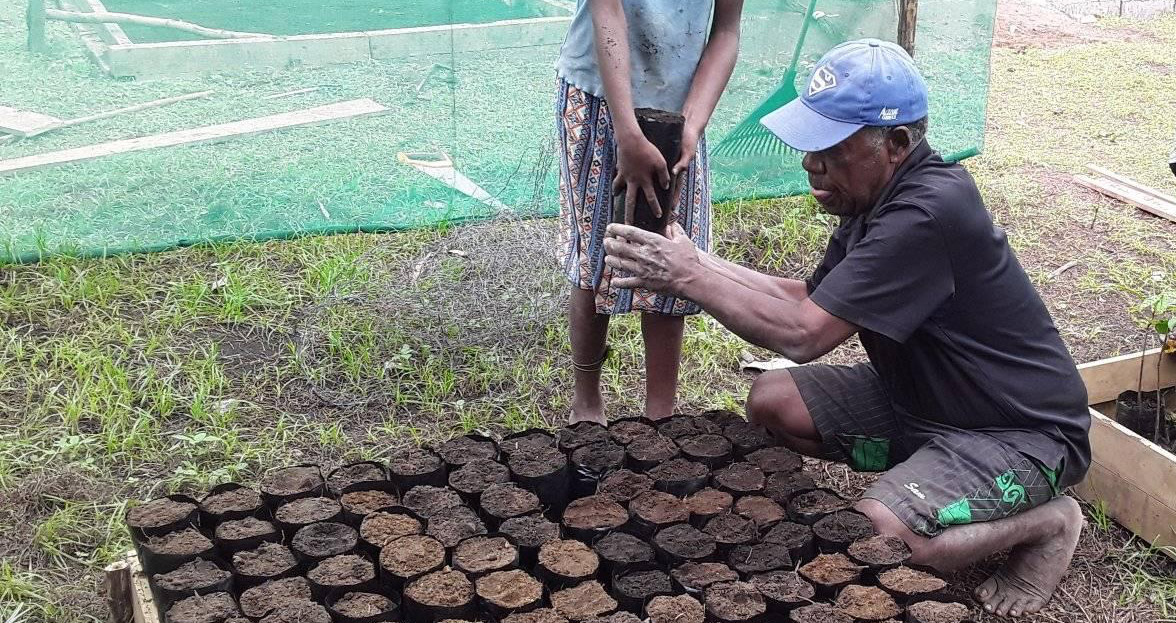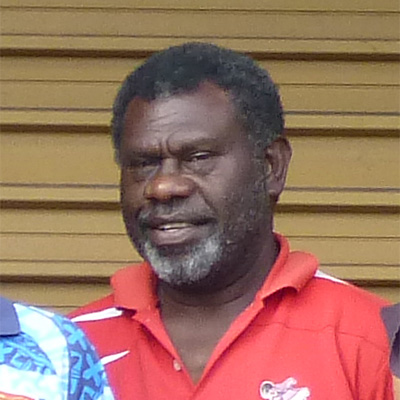
Above: Team researcher, Allan Dan assisting SPREP with a tree nursery project in Port Resolution.
Investments in island-scale agri-extension can help small-scale farmers reduce the risks of innovating with new techniques and crop variants as a response to environmental change. Such programmes improve productivity of household gardens and reduce pressure on forests and coastal reefs, which buffers communities reliant on natural resource harvesting against the impacts of climate change.
Background
Tanna communities have a long history of sustainable natural resource management and have developed a range of Kastomkastom Kastom is a pidgin word (Bislama/English) used to refer to traditional culture, including religion, economics, art and magic in Melanesia. The word derives from the Australian English pronunciation of 'custom'. Kastom is mostly not written, only passed down through teachings and stories and includes places, stories, objects and animals and plants. practices to conserve ecosystems. However, there is data that shows that coastal fisheries are under threat, garden productivity is falling, and deforestation continues.
Tanna is also vulnerable to climate change, including:
- more intense or frequent extreme weather;
- changing rainfall and weather patterns;
- coastal erosion and inundation; and
- coral bleaching, which can affect food security, tourism opportunities and makes communities more vulnerable in cyclones.
In addition, non-climate change-related risks, such as seismic and volcanic activity, further increase risk and social and economic development, and demographic pressures also play a role.
Promoting ecosystem-based adaptations (EbAEbA Ecosystem-based adaptation - an adaptation approach to climate- and environmental-change which primarily deploys ecosystems and ecosystem functions to mitigate risks from hazards.) to climate change provides opportunities for Tanna to meet the twin challenges of climate change and supporting livelihood improvements. Objective ENV 1.5 of Vanuatu National Sustainable Development Plan (NSDP) 2016–2030 connects EbA, food production, and habitat integrity. Specifically, it seeks to enhance traditional agricultural practices and focus on disaster risk reduction and climate change adaptation.
The traditional focus of EbA projects has been on habitat restoration and capacity building. Such projects seek to directly improve the functioning of ecosystems or help communities with their adaptation capabilities, both of which are vital to supporting community-based adaptation. This investigation took a different approach. High social returns on investment can be made from actions that stimulate innovations in activities from which rural communities derive their livelihoods. As 98% of all Tanna households perform some form of subsistence food production, improvements here can have far-reaching impacts.
Approach
As part of the EcoAdapt project, a team from Griffith University in Australia took a different approach by looking at the indirect benefits on ecosystems from decreasing the impact of activities that damage these ecosystems, such as improving the productivity of subsistence gardens. This will allow more food to be grown from the existing garden footprint, so reducing pressure on Tanna’s forests and coastal fisheries.
To develop this approach, between 2016 and 2017 the EcoAdapt team held several community-based data gathering events, including workshops, community focus groups, guided forest and reef transects, and formal interviews with the Tafea provincial government. Common themes were the importance of food and fibre production. Additional concerns were raised about shortening fallow periods and falling productivity of traditional crops. Women, specifically, raised a broader set of socio-economic concerns, associated with water, sanitation and health.
Potential solutions put forward included a focus on developing hybrid approaches to natural resource management practices, where traditional Nakamal decision making is augmented by formal governance instruments, backed by local by-laws. People also suggested new crops and growing techniques be trailed and more emphasis on livestock as a source of protein.
Benefit cost analysis (BCRBCR Benefit cost ratio - the ratio of a project's benefits to costs. If the BCR is greater that 1, the project provides an economic return on investment. If the BCR is less than 1, the project does not provide an economic return.)
BCA compares the relative value of net benefits and costs of a project over time, to determine the project’s value, on its own merits, from an all-of-society perspective. BCA provides for a ‘net present value’ (NPVNPV Net present value - the value of a project (benefits minus cost), over time, as judged from today's perspective, using a discount rate.) or a benefit cost ratio of a project. NPV is the total present value benefit minus the total present value cost for the project as a whole; secondly, the ‘benefit-cost ratio’ (BCR) is the ratio of the present value benefits to present value costs (this determines a ‘return on investment’ for each unit of present value cost incurred).
In each instance, future values are discounted back to today’s value. The feasibility of a project is assessed by determining whether the net social benefits are greater than the net social costs. Most BCA sets up a range of plausible scenarios, or configurations of the benefits and the costs, especially where data is subject to a level of uncertainty (such as in estimating environmental benefits). In all cases, the net benefits of a project should be compared against a base case (sometimes called ‘business as usual’), which represents the net benefits of what would have happened in the absence of the project being undertaken.
Proposed projects
We composed comprehensive budgets for two project component. Next, we then estimated the benefits to Tanna households, based on:
- direct use, or material benefits, such additional food production, fishing, incomes, and eco-tourism opportunities; and
- indirect uses, or ecosystem service benefits, which flow from the retention of or increase in the extent of coral and forest habitats.
Assessing the benefits from ecosystem servicesecosystem services Ecosystem services are the goods and services provided by nature which are experienced as or transformed into benefits for human society. They are generally classed as 'provisioning' (material things that are consumed), 'regulating' (non-material benefits derived from habitat functioning), and 'cultural' (non-material benefits obtained from an experience of nature, including tourism). was done through monetary valuation, of which there are various methods. Monetary valuation of ecosystem services is not the same as ‘putting a price on nature’. Instead, it is a way of being able to understand the benefits of tangible benefits and indirect benefits (and often intangible, cultural benefits) using a common metric, which we can compare often incomparable things and which we are most used to.
Each project component was budgeted to be spread over a 5 year implementation period, whilst the benefits were assessed over 25 years. This is because many of the benefits of the programme will continue into the future, long after the direct interventions have ended. The programme was built on two sets of projects:
- Demonstration garden plots and agricultural extension officers to trial new techniques and crop varieties for subsistence gardening; an upgrade to Tanna’s central plant nursery; and set-up of a community radio station to assist with the promotion of the project.
- Technical and logistical support for the establishment of marine and terrestrial community conservation areas (CCAs) to formalize and support reef and tropical forest conservation efforts.
Findings
The benefit-cost analysis (BCA) estimated there are significant social, economic and environmental benefits from improving the productivity of subsistence gardens on Tanna and so reducing pressures on forests and coastal coral reefs. Community conservation (either marine, terrestrial, or a combination of both) yield a neutral benefit, but from a more modest initial investment. Analysis indicates the net present value (NPV) (see Box 1) of the agri-extension project, with a supporting community outreach, of US$ 182.6 million (m), with a BCR of 93. In this model we predicted that after 25 years, around 32% of all Tanna house will improving the productivity of their subsistence. If no outreach is carried out (i.e. the household engagement process is less effective), the project still returns a NPV of US$ 86.6 m at a BCR of 74 (Table 3). We tested a range of scenarios for how much garden productivity could be improved.
Even if productivity could only be improved by 25% over 25 years, the BCR is still very high (US$ 38 m). For implementation of the CCACCA Climate change adaptation - actions or policies taken to adapt communities, infrastructure, nature, and the economy to mitigate risks from climate change and take advantages of opportunities. programme (marine and terrestrial) we estimate a NPV of US$ 3275 with a BCR of 1.01.
Implications
Our analysis for Tanna suggests that adaptation funding targeted at increasing the productivity of subsistence gardens returns very significant social, economic and environmental benefits. This conclusion is likely to hold across Vanuatu and the Pacific where subsistence farming is the source of most production. Therefore, the Tafea Provincial Government and the Vanuatu Government should prioritise partnering to pursue projects and funding sources that support agri-extension activities. Encouraging new and adaptive techniques can:
- help communities adapt to changes in crop growing conditions, more extreme weather events, and degradation of in-shore reefs;
- insure against chronic worsening food insecurity from falling yields and population growth; and
- take advantage of environmental co-benefits, such as forest cover to regulate soil, water, and micro-climate, protection of biodiversity, and contributions towards global efforts to sequester carbon.
As improvements to productivity can be potentially adopted by all households on Tanna that farm and can – through technology diffusion over a long period continue to be adopted – the social benefits are substantial. In addition, increasing the community capacity to balance formal forest and reef conservation with customary management can provide small, but nevertheless important complimentary social benefit.
Publication
Buckwell, A., Ware, D., Fleming, C., Smart, J. C., Mackey, B., Nalau, J., & Dan, A. (2020). Social benefit cost analysis of ecosystem-based climate change adaptations: a community-level case study in Tanna Island, Vanuatu. Climate and Development, 12(6), 495-510. https://doi.org/10.1080/17565529.2019.1642179
Acknowledgements
We are grateful for the on-the-ground assistance of ‘Uncle Allan’ (Allan Dan), as the Ecosystem and Socio-economic Resilience Analysis and Mapping (ESRAM) Tanna Island project officer, the Tafea Provincial Government for support and cooperation, the Tanna community for their hospitality, support, collaboration and sharing of local knowledge, and the three anonymous reviewers for their insightful comment.
About the lead author:
Andrew Buckwell
Applied environmental and resource economist and social scientist.
Dan Ware
Previous Project Manager for the EcoAdapt project
Allan Dan
In-country project coordinator for Tanna and Vanuatu.
Request a copy of the article
If the download article link below doesn’t work, or leads to a page that requests payment, please click the link to the author profile above and request a copy directly and they will be happy to assist. Not all reviewed journal articles are published as ‘open access’, which are free to download.


